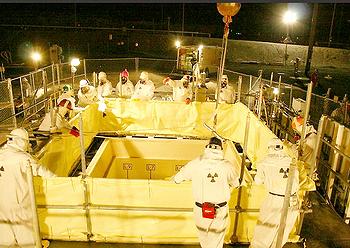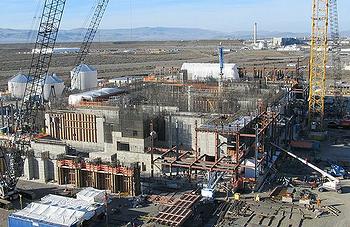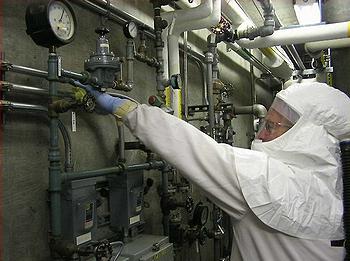Hanford Double-Shell Tank Leaks Nuclear Waste
RICHLAND, Washington, August 20, 2012 (ENS) – For the first time, a leak of highly radioactive waste has been detected from a double-shelled tank at the Hanford Nuclear Site in central Washington state.
The public interest group Hanford Challenge Friday released disclosed a memo from U.S. Department of Energy inspectors to the Washington State Department of Ecology detailing the leak.

Tank farm workers at the Hanford Nuclear Site (Photo courtesy Washington River Protection Solutions)
Dated August 14, the memo acknowledges a highly-radioactive chemical waste leak that was detected in early August from Tank AY-102 on the floor of the “annulus,” the space between the two walls of the double-shell tank.
The dry radioactive waste was found in two locations, according to the memo, one of them in a “mound approximately 2 ft. x 3 ft. x 8 inches.”
“This changes everything. It is alarming that there is now solid evidence that a Hanford double-shell has leaked,” said Hanford Challenge Executive Director Tom Carpenter. “These tanks were supposed to last another 40 years, but that thinking has been superseded by this new reality.”
The 586-square-mile Hanford Site on the Columbia River holds two-thirds of the nation’s high-level radioactive waste left over from plutonium production during World War II and the Cold War. Plutonium production ended at Hanford in 1988.
Today, Hanford is the most contaminated nuclear site in the United States and is the focus of the nation’s largest environmental cleanup.
The AY-102 tank is one of 177 underground nuclear waste tanks at Hanford, containing an estimated 56 million gallons of high-level nuclear waste.
The waste is being held until it can be treated at the world’s largest Waste Treatment and Immobilization Plant now under construction at the site.

The High-Level Waste facility exterior and canister export truck bay at the Hanford Waste Treatment Plant, June 2012 (Photo courtesy Bechtel National)
At the treatment plant the waste will be heated, mixed with glass-forming materials and poured into stainless steel containers. In this vitrified form, the waste is stable and impervious to the environment. Construction of the Vit Plant began in 2001 and is more than 65 percent complete, according to the contractor, Bechtel National, Inc.
Sixty-seven Hanford tanks have leaked over one million gallons of radioactive waste into the soil, but until now, all of them were the older-style, single-shell tanks.
The waste in the single-shell tanks is being moved into the tanks with double shells as a safety measure. Double-shelled tanks have two steel walls, with a “tank within a tank” design that adds to the safety margin.
The AY-102 tank is a double-shell waste tank, and had been considered to be stable and non-leaking.
“If we determine there was a leak or a previous spill, it reinforces the urgency of emptying the tanks and completing the mission,” Tom Fletcher, Department of Energy assistant manager of the tank farms, told the “Tri-City Herald” newspaper. “The tanks are not getting any younger.”
The Department of Energy has not confirmed exactly what the material is or where it came from, Fletcher said.
Investigators are attempting to determine whether waste leaked out of the inner shell of Tank AY-102 or the waste originated from another source, such as a pit with pumps or piping serving the AY Tank Farm.
The leak was discovered during video monitoring of an area that had not previously been subject to monitoring.
Now, the memo says, in the near term inspectors will examine “all accessible areas of tank annulus” and “sample and pump tertiary leak detection pit (confirms secondary liner integrity).

Hanford worker decontaminates equipment. (Photo courtesy Washington River Protection Solutions)
In the long term, inspectors will determine if other double-shell tanks are leaking and “explore means for removing material from annulus.”
Department of Energy, DOE, inspectors will increase monitoring in the area of the leak, with visual monitoring twice a week and level monitoring on each work shift; and they will sample the leaked waste material in both locations.
The Washington State Department of Ecology’s Nuclear Waste Program cleanup section manager Cheryl Whalen told the newspaper that if the double-shell tanks are leaking, “it will be a difficult situation” because it will hamper retrieval of the waste from the leak-prone single-shell tanks.
Since 2002, nearly two million gallons of waste have been retrieved from single-shell tanks at Hanford and transferred to the newer, double-shell tanks to await treatment.
Carpenter said, “This new evidence gives urgency to the suggestion that the DOE build more tanks. We always knew the double-shell tanks would leak, we just did not know when. We have the first, how many will be leakers in another 40 years?”
“The only good news here is that the waste from this tank leak was not in liquid form, and is apparently not yet affecting the environment,” he said.
Carpenter, who released the official memo detailing the leak, is critical of the Department of Energy for its lack of transparency.
“Officials have not made any kind of announcement about the leak, despite the fact that they have known for over a week,” he said. “The era of secrecy and hiding problems is supposed to be over, but old habits apparently die hard.”
Hanford Challenge also points to uncertainties around the opening of the Waste Treatment Plant, which is under scrutiny because of safety issues raised by whistleblowers. Carpenter says that is another reason why the government “should immediately build a new set of tanks to temporarily store Hanford’s deadly waste.”
Copyright Environment News Service (ENS) 2012. All rights reserved.